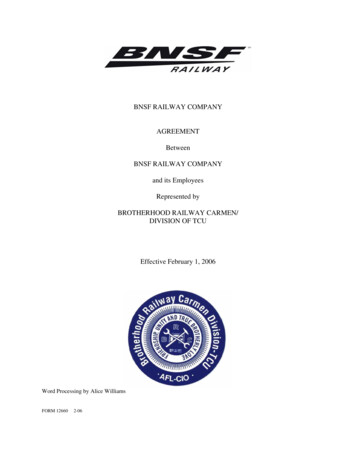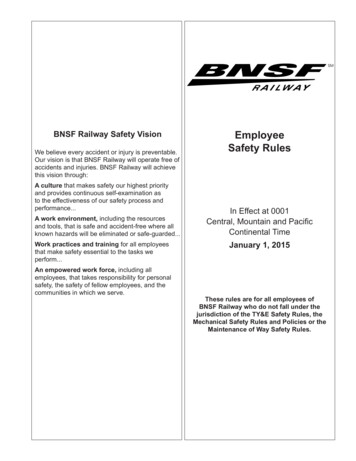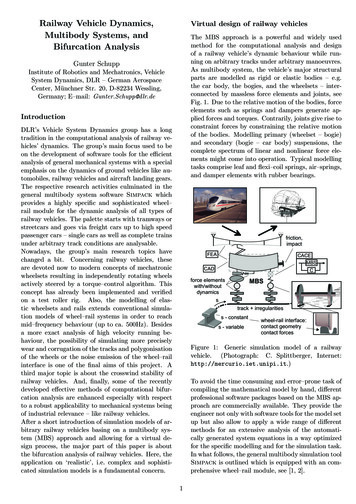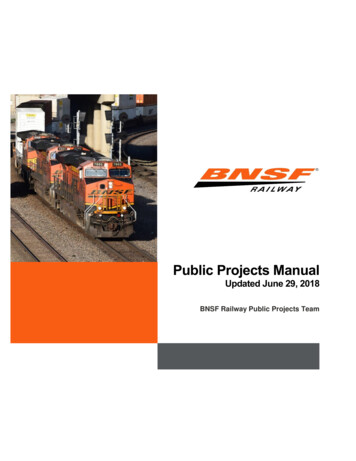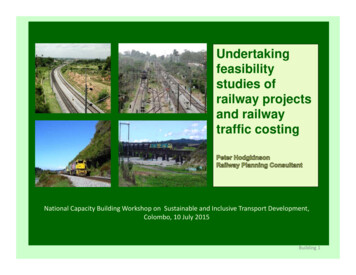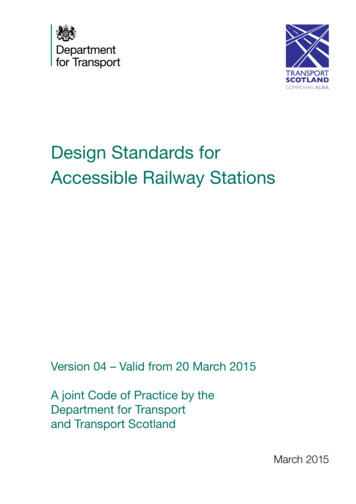
Transcription
Departmentfor TransportTRANSPORTSCOTLANDCOMHDHAIL ALBADesign Standards forAccessible Railway StationsVersion 04 – Valid from 20 March 2015A joint Code of Practice by theDepartment for Transportand Transport ScotlandMarch 2015
Although this report was commissioned by the Department for Transport (DfT), the fndings andrecommendations are those of the authors and do not necessarily represent the views of the DfT. Theinformation or guidance in this document (including third party information, products and services)is provided by DfT on an ‘as is’ basis, without any representation or endorsement made and withoutwarranty of any kind whether express or implied.The Department for Transport has actively considered the needs of blind and partially sighted peoplein accessing this document. The text will be made available in full on the Department’s website. Thetext may be freely downloaded and translated by individuals or organisations for conversion into otheraccessible formats. If you have other needs in this regard please contact the Department.Department for TransportRailways for All4/26 Great Minster House33 Horseferry RoadLondon SW1P 4DRTelephone 0300 330 3000Transport ScotlandBuchanan House58 Port Dundas RoadGlasgow G4 0HFGeneral enquiries https://forms.dft.gov.ukWebsite www.gov.uk/dftOGI. Crown copyright, 2008, 2010, 2011 and 2015, except where otherwise statedCopyright in the typographical arrangement rests with the Crown.You may re-use this information (not including logos or third-party material) free of charge in any formator medium, under the terms of the Open Government Licence v3.0. To view this licence visit ment-licence/version/3 or write to the Information Policy Team,The National Archives, Kew, London TW9 4DU, or e-mail: psi@nationalarchives.gsi.gov.uk.Where we have identifed any third-party copyright information you will need to obtain permission fromthe copyright holders concerned.ISBN 978-1-84864-154-92Code of Practice Version 04 – March 2015
Useful contactsUsers of this Code of Practice may seek advice, clarifcations orinformation on making dispensation applications, from the Railways for Allteam, by writing to the following address:Railways for All4/26 Great Minster House33 Horseferry RoadLondon SW1P 4DREmail railwaysforall@dft.gsi.gov.ukTransport ScotlandBuchanan House58 Port Dundas RoadGlasgow G4 0HFEmail info@transportscotland.gsi.gov.ukQueries relating to the adoption and application of the PRM TSI, includingits impact on rail vehicles, should be addressed to:Rail Executive – Infrastructure, Safety and Security4th Floor Great Minster House33 Horseferry RoadLondon SW1P 4DREmail railvehicleaccess@dft.gsi.gov.ukCode of Practice Version 04 – March 20153
AcknowledgementsIn compiling this Code of Practice, we would like to acknowledge the helpand co-operation of the following individuals and organisations:Abellio Greater AngliaAssociation of Train Operating CompaniesBritish Standards InstitutionChiltern RailwaysC2cDisabled Persons Transport Advisory CommitteeEast CoastEast Midlands TrainsLondon MidlandMerseyrailNetwork RailPaul BiglandScotRailSoutheasternSouthernSouth West TrainsThe Offce of Rail RegulationPassenger FocusAnd with particular thanks to the late Nick Shaw from Network Rail.The photographs contained within this Code of Practice were supplied byPaul Bigland or Justin Ryan, unless credited otherwise.Permission to reproduce extracts from British Standards is granted byBSI Standards Limited (BSI). No other use of this material is permitted.British Standards can be obtained in PDF or hard copy formats fromthe BSI online shop: www.bsigroup.com/Shop or by contactingBSI Customer Services for hard copies only: Tel: 44 (0)20 8996 9001,Email: cservices@bsigroup.com.4Code of Practice Version 04 – March 2015
ContentsForeword .9Introduction .10About the Code of Practice .11A1. Pre-travel information .15B1. Substitute transport – pre-planned and emergency .19C1. Car parking – general and location .22C2. Car parking – dimensions and number of spaces .27C3. Car parking – markings .32C4. Car parking – monitoring and enforcement .35D1. Set-down and pick-up points .37E1. Locating and approaching the station .42F1. Unobstructed progress – general .48F2. Unobstructed progress – building works .57G1. Doors .61H1. Lighting .67I1. Floors .71J1. Walls and transparent devices .78J2. Furniture and free-standing devices .82K1. Signs – general .85K2. Signs – directional information .92K3. Signs – font .95Code of Practice Version 04 – March 20155
K4. Signs – sign design .99K5. Signs – sign lighting .102K6. Signs – tactile (embossed and braille) signs .105K7. Signs – display screens .109K8. Signs – maps and detailed information .113L1. Announcements – general .115L2. Announcements – induction loops .119L3. Announcements – emergency alarms .122M1. Help points .124N1. Ticket sales points – booking offces, information andcustomer-service desks .127N2. Ticket sales points – ticket vending machines .131N3. Ticket sales points – ticket barriers .135O1. Lifts – general .138O2. Lifts – lift emergencies .145O3. Lifts – platform lifts (inside the station building) .147P1. Ramps .149Q1. Steps and stairs – general .157Q2. Steps and stairs – stair and step design .160Q3. Steps and stairs – landings and areas beneath stairs .163Q4. Steps and stairs – handrails .165R1. Escalators and moving walkways .169S1. Platforms – platform design .1736Code of Practice Version 04 – March 2015
T1. Seating, waiting rooms and shelters .181U1. Toilets – standard toilets .188U2. Toilets – provision and location of wheelchair-accessible toilets 190U3. Toilets – opening hours .194U4. Toilets – doors .196U5. Toilets – design and layout .199U6. Toilets – WC pan and cistern .203U7. Toilets – grabrails .206U8. Toilets – washbasins .210U9. Toilets – accessories and surface fnishes .212U10. Toilets – lighting .216U11. Toilets – emergency .218U12. Toilets – baby-changing facilities .221V1. Platform lifts for boarding trains .224W1. Crossing the track .228W2. Crossing the track – subways .232X1. Connecting transport .234Y1. Staff training .236Annex I. References .238Annex II. Exemptions from licence provision requiring thefollowing of the Code of Practice .242Annex III. Transportable wheelchair dimensions .246Annex IV. Dispensation and derogation process .248Annex V. Reference documents .249Code of Practice Version 04 – March 20157
8Code of Practice Version 04 – March 2015
ForewordForeword by Baroness KramerThere are over 10 million people in Great Britain with a disability and weare committed to improving their access to work and leisure. This includesimproving access to the UK’s railway stations, and this publication willhelp those delivering station infrastructure improvements to contribute tothat aim.There is something fundamentally unfair when a disabled passenger has totravel beyond the mainline station they need, simply to change trains, andtravel back again in order to reach the correct platform. By designing moreaccessible railway stations, you can start to change this.This is not only the right thing to do, it also makes good business sense,as passenger numbers can increase by up to 20% at stations wherestep-free access is provided.All infrastructure work carried out at stations needs to comply with the EUand domestic rules set out in this Code of Practice.Compliance with the Code is not gold plating, it is a requirement ofthe licence that each train operating company (TOC) and Network Railhas from the Offce of Rail Regulation (ORR), and it applies in all cases,whether it’s new, replacement or renewed infrastructure. The underlyingprinciple of this Code is that, whenever work takes place, the opportunityis taken to ensure the output of that particular work provides for improvedaccessibility. We expect operators to commit themselves to a programmeof continuous improvement on behalf of their disabled passengers.It doesn’t need to be a big deal or a big cost to a project. It just needscareful thought and designing in from the start – see it as an opportunity,not a problem. If you build it they will come.Code of Practice Version 04 – March 20159
IntroductionIntroductionThis Code fulfls the Secretary of State’s responsibility under Section 71Bof the Railways Act 1993 (as amended), to produce a Code of Practice“protecting the interests of users of railway passenger services or stationservices who are disabled”.1This updated Code replaces all previous versions, including Trainand Station Services for Disabled Passengers: A Code of Practice(the Blue Book) and Accessible Train Station Design for DisabledPassengers: A Code of Practice (November 2011). This latest revisionincorporates modifcations to the Commission Regulation (EU) No1300/2014 of 18 November 2014 on the technical specifcations forinteroperability relating to accessibility of the Union’s rail system forpersons with disabilities and persons with reduced mobility (PRM TSI).The version of the document published on the Department for Transport’s(DfT) website will be considered the offcial version for the purposes ofthe Railways Act 1993. Train and station operators, and anybody elsewho carries out work on Great Britain’s railway network, should ensurethat they are familiar with this version and should check the website on aregular basis for updates.If you have any questions regarding the Code of Practice, please contactthe Railways for All team using the address at the start of this document.110Railways Act 1993, s.71B. Available at pb12-l1g70Code of Practice Version 04 – March 2015
About the Code of PracticeAbout the Code of Practice1.The purpose of the Code is to ensure that any infrastructure work atstations makes railway travel easier for disabled passengers. It appliesto services provided by operators in Great Britain in relation to trainsand stations.2.The Code identifes European and national standards relevant forall passenger train and station operators in Great Britain. Licensedoperators, including Network Rail must follow the Code, acondition of their licence, whenever they install, renew or replaceinfrastructure or facilities. This includes the requirement to establishand comply with a Disabled People’s Protection Policy (DPPP), payingdue regard to this Code.3.The Code contains mandatory European standards (fromthe Persons with Reduced Mobility Technical Specifcation forInteroperability) which must be applied when any “major work” isbeing undertaken; mandatory national standards which must beapplied to all other installations, renewals or replacements; and bestpractice guidance which should be applied wherever possible.4.Under the Railways (Interoperability) Regulations 2011, all new workand upgrade or renewal work, under the PRM TSI, on Great Britain’srail system will require an authorisation to place into service fromthe national safety authority (ORR), unless the project has received adecision from the Department that an authorisation is not required forupgrade or renewal of the work.5.A revised PRM TSI came into force on 1 January 2015 so all newwork, upgrades or renewals are now subject to the revised TSI. ThePRM TSI scope has been extended to cover the entire rail network.It will apply where new trains or stations are introduced, or wheretrains or stations undergo major work, on any part of Great Britain’sCode of Practice Version 04 – March 201511
About the Code of Practicerail network. It is possible that some installations, replacements orrefurbishments do not constitute upgrade or renewal work but are stillsubject to European or national standards referred to in this Code.6.Details of operators who either do not hold licences and so are notrequired to produce a DPPP, or who are otherwise exempted fromthe licence condition to have regard to the Code of Practice are inAnnex II.Defnition of “station”7.The Code of Practice applies in all public circulation areas withinrailway stations. A station is defned in Section 83 (1) of the RailwaysAct 1993 as:“Any land or other property which consists of premises used as, or forthe purposes of, or otherwise in connection with, a railway passengerstation or railway passenger terminal (including approaches, forecourt,cycle store or car park), whether or not the land or other property is, orthe premises are, used for other purposes.”Defnition of ‘disability’8.This Code assumes the same defnition of disability as the EqualityAct 2010:“A physical or mental impairment that has a substantial and long termadverse effect on a person’s ability to carry out normal day-to-dayactivities.”12Code of Practice Version 04 – March 2015
About the Code of PracticeThe scope9.This Code of Practice is relevant to all passenger train and stationoperators in Great Britain. It does not apply to Northern Ireland.10. The Railways Act 2005 granted Scottish ministers the power toproduce their own Code of Practice to apply to services and stationsin Scotland. Until such time as Scottish ministers choose to producea separate Code of Practice, this Code will apply in Scotland. Allreferences to external rules in England and Wales, such as theBuilding Regulations, shall be assumed to be referring, in addition, tothe appropriate Scottish standard.11. With certain exceptions set out in Annex II, operators are requiredto meet the European and national standards, as set out in the mainbody of this Code, when providing new, renewed or replacementfacilities on passenger trains or at stations. The Code does notimpose an obligation on operators to take action to enhanceaccessibility in other circumstances.12. Following the guidance sections is not mandatory. However, this isbest practice so it is strongly recommended that it is followed wherepossible.Dispensation process13. Where a non-exempt station scheme, undertaken by a licensedoperator, cannot meet the European or national standards in thisCode of Practice, the scheme promoter must contact the DfT to applyfor a dispensation. Please see Annex IV for further details.Code of Practice Version 04 – March 201513
About the Code of PracticeEnforcement14. All licences issued to passenger train and station operators by theOffce for Rail Regulation (ORR) contain a condition that, in drawingup their Disabled People’s Protection Policies (DPPPs) licensees willpay due regard to the Code of Practice.15. Furthermore, it is a standard condition of each operator’s DPPP thatthey will follow the Code of Practice.16. Compliance with the Code of Practice should therefore be treated inthe same manner as compliance with any other licence condition. Byfailing to comply with the Code of Practice, an operator is in breach oftheir licence and may be subject to enforcement action by the ORR.17. Operators should note that, in cases where the European andnational standards are not prescriptive, they may fnd it diffcult todefend themselves against action taken by an individual under theEquality Act 2010, if they cannot demonstrate that they have taken allreasonable steps, equivalent to those recommended in the Code ofPractice guidance.Updating the Code18. Users must be sure at all times that they are using the most up-to date version of this Code of Practice. There is a version number anddate on each Code of Practice to help them to do this.19. The latest version will be available on the Department’s website atwww.gov.uk/dft and users, particularly those who have printed a hardcopy, are recommended to check there on a regular basis so as to beaware of any changes to standards or guidance.14Code of Practice Version 04 – March 2015
A1. Pre-travel informationA1. Pre-travel informationGood information is vital. In addition to the same information as anyoneelse, disabled passengers may need extra information to enable them toundertake and complete their journey in reasonable safety and comfort.A1.A1.European standardsReferenceInformation regarding the level of accessibilityof all stations must be freely available.Operating rules shall be made to ensure thatinformation regarding the level of accessibilityof all stations is available.PRM TSI: 4.4.1National standardsReferenceThis section contains no national standards butoperators ought to refer to How to Write YourDisabled People’s Protection Policy: A Guidefor Train and Station Operators for thoroughguidance on the statutory requirements relatingto this issue. An overview of these requirementsis given below.How to WriteYour DisabledPeople’sProtectionPolicy: AGuide for Trainand StationOperatorsCode of Practice Version 04 – March 201515
A1. Pre-travel informationA1.Code of Practice guidanceReferencea.Should a disabled person require assistanceor the use of any additional facilities, theyshould be reassured that it will be provided,and be able to rely on the fact that it will be asarranged.b.Accessibility information ought, as a minimum,to cover the following areas: car parking facilities; local transport interchanges (bus stops,drop-off and pick-up points); doors and single-level entrances; obstacle-free routes through the station; foor surfaces, glass and wall markings,tactile information; toilets and baby-changing facilities; station furniture (seating, waiting rooms); ticket offces and ticket vending machines; information desks and customer assistancepoints; visual and spoken information; ramps, lifts and escalators; stairs, steps and handrails; boarding aids;16Code of Practice Version 04 – March 2015
A1. Pre-travel informationA1.Code of Practice guidanceReference platform width, edge of platform and endof platform; lighting; level track crossings; commercial outlets, telephones, vendingmachines.Most of the above information is located onthe Stations Made Easy application on theNational Rail Enquiries website, which shouldbe regularly checked and updated for accuracy.c.As well as stating whether the facility exists atthe station, it may also be pertinent to outlinewhether the facility is available at all times thattrains run and what issues a passenger mayface. For example, a fight of stairs may have 32steps but may incorporate resting spaces.d.Accessibility information should be available ina range of formats, including large print, audioand braille.Code of Practice Version 04 – March 201517
A1. Pre-travel informationA1.Code of Practice guidanceReferencee.Passengers should be able to readily obtainthe accessibility information for a particularstation from the station operator’s phone line,on the internet and by request from any of theoperator’s ticket offces or customer informationpoints. Online information should be accessibleto all users, in accordance with the W3C WebAccessibility Initiative’s criteria for “Triple-A”compliance.W3C WebAccessibilityInitiative:Web ContentAccessibilityGuidelines 1.0f.Potential passengers ought to be able to fndout in advance where they can catch their train,when it will leave, where they have to change,and what help or facilities are available for theirparticular needs.g.If a station accessibility level changes (forexample, a lift breaks down), then the operatorshould publicise this promptly, includingan approximate timescale for any repairs,and update the Station Journey Planner bycontacting the helpdesk.18Code of Practice Version 04 – March 2015
B1. Substitute transport – pre-planned and emergencyB1. Substitute transport –pre-planned and emergency Figure B1.1 Sign for substitute transport – a replacement bus service. Theforeground shows bollardsCode of Practice Version 04 – March 201519
B1. Substitute transport – pre-planned and emergencyB1.European standardsReferenceThe Infrastructure Manager or Station Manager PRM TSI: 4.5.1shall have procedures that include the provisionof alternative assistance to PRM duringmaintenance, replacement or repair of facilitiesthat are for PRM use.B1.National standardsReferenceThe obligations within this section are alsoTransport Actunderpinned by statute. Section 248 of the2000Transport Act 2000 requires operators toensure, so far as is reasonably practicable,that the substitute road services allow disabledpassengers to undertake their journeys safelyand in reasonable comfort. This should includepassengers who have suffered an injury thatseriously impairs their ability to walk. Financialliabilities can arise if operators fail to meet theserequirements.20Code of Practice Version 04 – March 2015
B1. Substitute transport – pre-planned and emergencyB1.Code of Practice guidancea.Buses or other substitute transport (Figure B1.1)should be accessible to disabled people.b.Passenger train operators should ensure thataccessible substitute transport is providedduring such engineering works.c.Where passenger train services are affectedby engineering works or an emergency thatleads to serious disruption, at short notice, it isrecommended that passenger train operatorsprovide accessible buses, where reasonablypracticable, at no extra charge. Where thiscannot be achieved, operators should ensurethat other alternative accessible transport isavailable to disabled passengers, such asaccessible taxis, at no extra charge and thatthese alternative travel arrangements arepromoted.d.Operators should ensure that any alternativeaccessible transport will carry assistance dogs,where applicable. This must never be at extracost to the owner.e.Operators should ensure that this informationis supplied to National Rail Enquiries and otheraccessible information services and station staffon affected routes as soon as possible.Code of Practice Version 04 – March 2015Reference21
C1. Car parking – general and locationC1. Car parking – general and locationFigure C1.1 Car park signFigure C1.2 Blue Badge holder parking spaces in use22Code of Practice Version 04 – March 2015
C1. Car parking – general and locationC1.European standardsReference1.Where a station-specifc parking area exists,there shall be suffcient and adapted parkingspaces reserved for PRM eligible to utilisethem (Figures C1.1 and C1.2) at the nearestpracticable position, within the parking area, toan accessible entrance.PRM TSI:4.2.1.12.The European TSI requirement is that UKnational standards are followed to ensureconsistency across the UK. Therefore, thenational standards below must be followed.PRM TSI: 4.2.1C1.National standardsReference1.A sign or, if appropriate, signs should beprovided at the entrance to each car park andat each change in direction to direct disabledmotorists to designated parking spaces.BS 8300:4.4.12.Designated disabled persons’ parking spaces(Figure C2.1) should be located on frm andlevel ground, as close as is feasible to theaccessible entrance. Access routes on levelground should have resting places not morethan 50 m apart for people with limited mobility.BS 8300:4.2.2Code of Practice Version 04 – March 2015BS 8300:5.123
C1. Car parking – general and locationC1.National standardsReference3.Any vehicle height barrier should provide avertical clearance on level ground of 2600 mmfrom the carriageway to allow the passageof a high-top conversion vehicle. The verticalclearance of 2600 mm should be maintainedfrom the entrance of the car park to (andincluding) the designated parking spaces andexits from those spaces.BS 8300:4.4.34.Height restrictions should be clearlysignposted, at a point before drivers begin toenter the car park. For existing car parks, if itis not feasible to maintain the recommendedvertical clearance along the route, there shouldbe directions to suitable alternative designatedparking spaces.BS 8300:4.4.35.Where designated on-street parking bays areprovided, they should be sited where roadgradient and camber are reasonably level,e.g. 1:50.BS 8300:4.124Code of Practice Version 04 – March 2015
C1. Car parking – general and locationC1.Code of Practice guidancea.All requirements and recommendations in thissection apply to station car parks that are partof the operator’s lease. Where the car park isoperated by a third party, the station operatorshould ensure that conditions are introducedat the next review of the contract to requirecompliance with the standards in the Code.b.It is recommended that, wherever possible,there is direct pedestrian access to the stationwithout the need to confict with road traffc.c.Co-operation between the operator and thehighway authority (or other party) is expected inorder to provide suitable crossing points wherethere is a road between the car park and thestation.d.It is recommended that, where practicable,disabled persons’ car parking spaces arecovered with a shelter to protect people withmobility diffculties from the elements while theytransfer to or from their vehicles.e.If there are alternative routes between thestation and the designated disabled persons’parking spaces, the preferred route forwheelchair users should be clearly signposted.Code of Practice Version 04 – March 2015Reference25
C1. Car parking – general and locationC1.Code of Practice guidancef.It is recommended that an accessible helppoint that can be used by all users, includingwheelchair users, to summon assistance fromstaff is installed near the designated disabledpersons’ parking spaces.g.It is also recommended that further helppoints are installed in the car park(s) to assistcustomers who may need help but who are notBlue Badge holders.h.Where car parking is split into short and longstay, all blue badge holder parking bays andenlarged standard spaces should be locatedtogether, as near as feasible to the stationentrance.i.It is recommended that there is an accessibleroute between the general car parking and thestation. This means that if all of the disabledspaces are occupied, a disabled person canstill use the main car park.j.Height restrictions should be clearly signposted,at a point before drivers begin to enter the carpark.26ReferenceCode of Practice Version 04 – March 2015
C2. Car parking – dimensions and number of spacesC2. Car parking – dimensions and numberof spaces6 6(101Ic;)-!---
users of this code of practice may seek advice, clarifcations or information on making dispensation applications, from the railways for all team, by writing to the following address: railways for.
